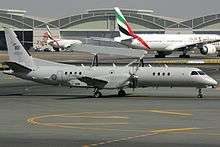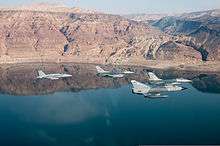Pakistan Air Force
The Pakistan Air Force (PAF) (Urdu: پاک فِضائیہ—Pāk Fizāʾiyah, Urdu: [pɑːk fɪzɑːɪjəɦ] or alternatively Urdu: پاکستان ہوائی فوج, Reporting name: PAF) is the aerial warfare service branch of the Pakistan Armed Forces, tasked primarily with the aerial defence of Pakistan, with a secondary role of providing air support to the Pakistan Army and Navy when required. The PAF has a tertiary role of providing strategic air transport and logistics capability to the Government of Pakistan. As of 2017, per the IISS, the PAF has 70,000 active-duty personnel and operates 871 aircraft.[5][6]
Its primary mandate and mission is "to provide, in synergy with other inter-services, the most efficient, assured and cost effective aerial defence of Pakistan." Since its establishment in 1947, the PAF has been involved in various combat operations, providing aerial support to the operations and relief efforts of the Pakistani military.[7] Under Article 243, the Constitution of Pakistan appoints the President of Pakistan as the civilian Commander-in-Chief of the Pakistan Armed Forces. The Chief of Air Staff (CAS), by statute a four-star commissioned air officer, is appointed by the President with the consultation and confirmation needed from the Prime Minister of Pakistan.[8] The Pakistan Air Force is currently commanded by Air Chief Marshal Mujahid Anwar Khan.[9]
History
1959 Indian aerial intrusion
On 10 April 1959, on the occasion of the Eid ul-Fitr festival holiday in Pakistan, an Indian Air Force (IAF) English Electric Canberra B(I)58 of No. 106 Squadron entered Pakistani airspace on a photo reconnaissance mission. Two Pakistan Air Force (PAF) F-86F Sabres (Flt. Lt. M. N. Butt (leader) and Flt. Lt. M. Yunis) of No. 15 Squadron on Air Defence Alert (ADA) were scrambled from Sargodha Air Base to intercept the IAF aircraft. Butt attempted to bring down the Canberra by firing his Sabre's machine guns, but the Canberra was flying at an altitude of more than 50,000 feet – beyond the operational ceiling of the F-86F. When Yunis took over from his leader, the Canberra suddenly lost height while executing a turn over Rawalpindi. Yunis fired a burst that struck the Canberra at an altitude of 47,500 feet and brought it down over Rawat, marking the first direct aerial victory of the PAF. Both crew members of the IAF Canberra ejected and were captured by Pakistani authorities. They were subsequently released after remaining in detention for some time.[10]
Indo-Pakistani War of 1965
The PAF fleet at the time consisted of 12 F-104 Starfighters, some 120 F-86 Sabres and around 20 B-57 Canberra bombers.[11] The PAF claims to have had complete air superiority over the battle area from the second day of operations.[12] However, IAF Air Chief Marshal Arjan Singh claimed that, despite having been qualitatively inferior to the PAF, the IAF allegedly achieved total air superiority in three days.[13]
Many publications have credited the PAF's successes in combat with the IAF to its U.S.-quality equipment, claiming it to be superior to the aircraft operated by the IAF and giving the PAF a "qualitative advantage". This statement has been refuted by some officials in Pakistan, as per them, the IAF's MiG-21, Hawker Hunter and Folland Gnat aircraft had better performance than the PAF's F-86 fighters, without accounting for the obvious quantitative advantage that the IAF possessed.[14] According to retired PAF Air Commodore Sajad Haider, the F-86 Sabre was inferior in terms of both power and speed to the IAF's Hawker Hunter.[14][15][16][17]
Sajad Haider, who flew with No. 19 squadron also stated that the F-104 Starfighter did not deserve its reputation as "the pride of the PAF" because it "was unsuited to the tactical environment of the region. It was a high-level interceptor designed to neutralize Soviet strategic bombers in altitudes above 40,000 feet." Nevertheless, the IAF is believed to have feared facing the Starfighter in combat[15] despite its lack of effectiveness in comparison to the IAF's fleet of Folland Gnats.[18] According to Indian sources, the F-86F performed reasonably well against the IAF's Hunters but not as well against the Gnat, which was nicknamed the Sabre Slayer by the IAF.[19][20]
Per India, most of the aircraft losses of the IAF were allegedly on the ground while the PAF suffered most of their losses in aerial combat.[21] Even though the IAF ran a larger offensive air campaign by devoting 40% of its air effort to offensive air support alone, the majority of its losses allegedly came from aircraft destroyed on the ground through PAF airstrikes, according to Indian officials.[21] The Indians claimed that the PAF had achieved far more in terms of enemy aircraft destroyed on the ground but the IAF had achieved much more in aerial combat, a claim that has widely been accepted by most international sources as "a stretch".[21]
The two countries have made contradictory claims of combat losses during the war and few neutral sources have verified the claims of either country, as is the case with most India-Pakistan conflicts. The PAF claims that it shot down 104 IAF aircraft and lost 19 of its own, while the IAF claimed it shot down 73 PAF aircraft while losing 60 of its own.[22] According to most independent and neutral sources, the PAF lost some 20 aircraft while the IAF lost somewhere between 60–75.[23][24] Despite the intense fighting throughout the course of the war, the conflict was effectively a stalemate and inconclusive in its result.[25]
Indo-Pakistani War of 1971
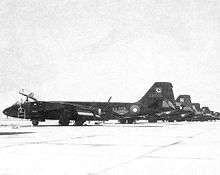
By late 1971, the intensification of the independence movement in erstwhile East Pakistan led to the Bangladesh Liberation War between West Pakistan and East Pakistan (later joined by India).[26] On 22 November 1971, 10 days before the start of a full-scale war, four PAF F-86 Sabre jets attacked Indian and Mukti Bahini positions at Garibpur, near the international border. Two of the four PAF Sabres were shot down and one damaged by the IAF's Gnats.[27] On 3 December, India formally declared war against Pakistan following massive preemptive strikes by the PAF against IAF installations in Srinagar, Ambala, Sirsa, Halwara and Jodhpur. However, the IAF did not suffer any significant losses because the leadership had anticipated such a move and consequently, precautions were taken.[28] The IAF was quick to respond to Pakistani airstrikes, following which the PAF carried out mostly defensive sorties.[29]
Hostilities officially ended at 14:30 GMT on 17 December, after the fall of Dacca on 15 December. The PAF flew about 2,840 sorties and destroyed 45 IAF aircraft while losing 75 of its own.[30]
1979–1989 Soviet–Afghan War
In 1979, the PAF's Chief of Air Staff, Air Chief Marshal Anwar Shamim, was told by then-President and Chief of Army Staff General Zia-ul-Haq, that Pakistan had reliable intelligence on Indian plans to attack and destroy Pakistan's nuclear research facilities in Kahuta. ACM Shamim told General Zia-ul-Haq that, in the PAF's current state, "Indian aircraft could reach the area in three minutes whereas the PAF would take eight minutes, allowing the Indians to attack the facility and return before the PAF could defend or retaliate". Because Kahuta was close to the Indian border, a consensus was reached acknowledging that the best way to deter a possible Indian attack would be to procure new advanced fighters and weaponry. These could be used to mount a retaliatory attack on India's nuclear research facilities in Trombay in the event of an Indian attack on Kahuta. It was decided the most suitable aircraft would be the F-16 Fighting Falcon, which the United States eventually agreed to supply after the PAF refused to purchase the F-5. In 1983, when the first batch of F-16s reached Pakistan, ACM Shamim informed Zia of the PAF's increasing capability to effectively respond to an attack on the nuclear research facilities at Kahuta.[31][32]
Due to rising tensions with the Soviet Union due to its invasion of Afghanistan, Pakistan's ISI systematically coordinated with the CIA, MI6 and Mossad to secure American resources and armaments for the Afghan mujahideen who were combating the invading Soviet forces.Various reports during this period widely indicated that the PAF had in fact covertly engaged in aerial combat against the Soviet Air Force in support of the Afghan Air Force during the course of the conflict;[33] one of which belonged to Alexander Rutskoy.[33]
A letter of agreement for up to 28 F-16A and 12 F-16B was signed in December 1981. The contracts, Peace Gate I and Peace Gate II were for 6 and 34 Block 15 models respectively, which would be powered by the F100-PW-200 engine. The first Peace Gate I aircraft was accepted at Fort Worth in October 1982. Two F-16A and four F-16B were subsequently delivered to Pakistan in 1983, with the first F-16 arriving at PAF Base Sargodha (now known as PAF Base Mushaf) on 15 January 1983 flown by Squadron Leader Shahid Javed. The 34 remaining aircraft as part of Peace Gate II were delivered between 1983 and 1987.[34][35]
Between May 1986 and November 1988,[36] the PAF's newly-acquired F-16s had shot down at least eight intruding aircraft from Afghanistan. The first three of these (one Su-22, one probable Su-22, and one An-26) were shot down by two pilots from No. 9 Squadron. Pilots of No. 14 Squadron destroyed the remaining five intruders (two Su-22s, two MiG-23s, and one Su-25).[37] Most of these kills were by the AIM-9 Sidewinder, but at least one (a Su-22) was destroyed by cannon fire. Pakistani Flight Lieutenant Khalid Mahmoud is credited with three of these kills.[38][39]
The PAF is believed to have evaluated the French Dassault Mirage 2000 in early 1981 and was planning to evaluate the F-16 Fighting Falcon afterwards.[40]
U.S. arms embargo (1990–2001)
| Pakistan Air Force | |||||
|---|---|---|---|---|---|
 | |||||
| History | |||||
| History of the PAF | |||||
| Aircraft | |||||
| Air Force weaponry | |||||
| Units and infrastructure | |||||
|
|||||
| Personnel | |||||
|
|||||
| Other information | |||||
|
|||||
After the Pressler amendment was passed, the United States placed sanctions and an arms embargo on Pakistan starting on 6 October 1990 due to the continuance of the country's nuclear weapons research program. All eleven Peace Gate III F-16s, along with seven F-16A and ten F-16B of the 60 Peace Gate IV F-16s, which had been built by the end of 1994 were embargoed and put into storage on U.S. soil.[34][35]
Desperate for a new high-tech combat aircraft, between late 1990 and 1993 the PAF evaluated the European Panavia Tornado MRCA (multi-role combat aircraft), and ultimately rejected it. France's Dassault Mirage 2000E and an offer from Poland for the supply of MiG-29s and Su-27s were also considered, but no deal materialized. In 1992, the PAF once again looked towards the French Mirage 2000, reviving a proposal from the early 1980s to procure around 20–40 aircraft, but a sale did not occur because France did not want to sell a fully capable version due to pressure from the United States. In August 1994, the PAF was offered the Saab JAS-39 Gripen by Sweden, but the sale did not occur because 20% of the Gripen's components were sourced from the U.S., which was still maintaining sanctions on Pakistan.[41]
In mid-1992, Pakistan was close to signing a contract for the supply of 40 Dassault Mirage 2000s, equipped with Thomson-CSF RDM/7 radars from France, although U.S. sanctions also prevented this deal from finalizing[42]
In mid-1994, it was reported that Russian manufacturers Sukhoi and Mikoyan were offering the Su-27 and MiG-29,[43] but Pakistan was reported to be negotiating for supply of the Mirage 2000-5.[44] French and Russian teams visited Pakistan on 27 November 1994 and it was speculated that the interest in Russian aircraft was to pressure France into reducing the price of the Mirage 2000. The stated requirement was for up to 40 aircraft.[45]
War in Afghanistan (2001–present)
The Pakistan Air Force is believed to have had a primary role in the alleged evacuation of Taliban personnel by the Pakistani military from Afghanistan. However, Pakistani and American officials have denied any such airlift taking place.[46][47]
2008 post-Mumbai attacks air alert
After the 2008 Mumbai attacks, the Pakistan Air Force was put on high alert in anticipation of any potential Indian accusations and offensives. It deployed to all its wartime locations and started routine combat air patrols. The speed and intensity of the deployment and PAF's readiness took the Indian Army High Command by surprise and later reports suggest that was the main factor to influence the Indians' decision of not going for cross border raids inside Pakistan.[48][49] The PAF was issued a standing order to launch an immediate counter-attack in case of an air attack from India, after a call from the Indian Foreign Minister Pranab Mukherjee to the Pakistani President Asif Ali Zardari (the call later turned out to be a hoax).[48][49][50][51][52]
2011 U.S. raid in Abbottabad
An initial investigation report revealed that the Pakistan Air Force (PAF) reported the movement of some half-a-dozen planes near the Jalalabad border at 23:00 before American helicopters entered Abbottabad to kill Osama bin Laden. "One aircraft was identified as a US AWACS and the remaining five were recognized as F-18 jets of the US. These planes flew near the Pakistani border, but did not cross into the airspace of Pakistan,"[53]
On the detection of an intrusion, PAF jets on air defence alert were scrambled and the PAF immediately took adequate operational measures as per standard operating procedure. The PAF aircraft continued their presence in the Abbottabad area until early morning and later returned to their air bases.[54]
However, the fact that so many non-stealth aircraft had entered Pakistani airspace, stayed for three hours to carry out a major operation, and that PAF jets only arrived at the location 24 minutes after the American helicopters had left made a senior PAF official term it "one of the most embarrassing incidents in Pakistan's history".[55]
Counter-insurgency operations in North-West Pakistan (2001–present)
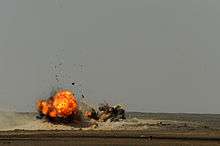
The Pakistan Army faced several problems during its 2009 offensive against the Taliban in North-West Pakistan. Hundreds of thousands of Pakistanis vacated the area when the offensive was announced and, eventually, over two million had to be accommodated in refugee camps. The offensive was to be completed as quickly as possible to allow the refugees to return to their homes but the army's fleet attack helicopters were not sufficient enough to provide adequate support to infantry on the ground. The PAF was sent into action against the Taliban to make up for the lack of helicopter gunships. Because the PAF was trained and equipped to fight a conventional war, a new "counter-terrorist doctrine" had to be improvised.[56]
The PAF's Saffron Bandit exercise focused on extensive training of combat personnel to undertake COIN operations. New equipment was inducted to improve the PAF's joint intelligence, surveillance and reconnaissance (ISR) capabilities. A C-130 transport aircraft was indigenously modified for day/night ISR operations.[56][57]
Use of laser-guided bombs was increased to 80% of munitions used, as compared to 40% in the previous 1960s Bajaur campaign. A small corps of ground spotters were trained and used by the PAF, in addition to Pakistan Army spotters, to identify high-value targets.[58]
Prior to the Pakistan Army's offensive into South Waziristan, the PAF attacked militant infrastructure with 500 lb and 2000 lb bombs.[58]
A number of civilian casualties occurred during PAF airstrikes on 10 April 2010 in the FATA tribal region. According to sources from the Pakistani military, the first bombing was targeted at a gathering of militants in a compound. Locals who had quickly moved onto the scene of the first airstrike to recover the dead and wounded were then killed by a second airstrike. While there is no confirmed death toll, it is widely believed that at least 30 civilian deaths had occurred according to the military approximations, whereas a local official stated that at least 73 locals, including women and children, were killed.[59] A six-member committee of tribal elders from the area tasked with finding the exact number of civilian casualties reported that 61 civilians were killed and 21 were wounded. This was not confirmed by government figures but Pakistan's then-Chief of Army Staff, General Ashfaq Kayani, gave a public apology on 17 April.[60][61] It is reported that BBC News and several other media correspondences were not allowed to take interviews from the injured.[62]
2019 India–Pakistan standoff
Following the Pulwama attack in Jammu and Kashmir, India conducted offensive airstrikes in the vicinity of the town of Balakot in Khyber Pakhtunkhwa province,[63] several miles inside the province's boundary with Pakistan-administered Kashmir.[64] Pakistan's military, the first to announce the airstrike on the morning of 26 February, described the Indian planes as dropping their payload in an uninhabited wooded hilltop area near Balakot after being intercepted by PAF fighter jets.[65]
On 27 February 2019, when a standoff between India and Pakistan had begun, Pakistan launched a counter-offensive by striking six targets near Indian military installations. Indian Air Force jets were scrambled to intercept the PAF jets inside Jammu and Kashmir. Following the interception, a fierce dogfight ensued and Pakistani JF-17s shot down an Indian MiG-21 and Sukhoi Su-30MKI.[66][67] India stated that it had only lost a single aircraft (a MiG-21) while claiming to have shot down a Pakistani F-16.[68] Pakistan rejected India's statement, stating that no F-16s were deployed.[69] Wing Commander Abhinandan Varthaman, who was piloting the MiG-21 Bison, was captured and arrested by the Pakistani military upon being shot down. He was held for two days before being released at the Wagah-Attari border crossing on 1 March.[70] By 6 April, Pakistan had come under international scrutiny over the persistent Indian allegations of having used its F-16s to conduct its counter-offensive into Indian-administered Kashmir (which would be a severe violation of the contract terms Pakistan had agreed to with the United States upon purchasing the F-16s) when Indian officials displayed what appeared to be debris from a downed Pakistani F-16 (though the jet remains unfound). In response to these allegations, Pakistan summoned U.S. defence officials to conduct a full investigation of Pakistan's American military arsenal. It was later revealed in a conclusive investigation that U.S. defence officials, having performed a count and inspection on the insistence of Pakistan, that all of the Pakistan Air Force's F-16s were present and accounted for with no damage whatsoever, debunking India's claims. The pilot who downed Varthaman's MiG was identified as PAF Squadron Leader Hasan Siddiqui, who was credited with engaging and downing the Indian aircraft in his JF-17.[71]
Structure
Commands
- Air Force Strategic Command (AFSC), Islamabad
- Northern Air Command (NAC), Peshawar
- Central Air Command (CAC), Lahore
- Southern Air Command (SAC), Karachi
- Air Defence Command (ADC), Rawalpindi
Bases
The PAF has 21 airbases of which 13 are flying bases and 8 are non-flying bases. Flying bases are operational bases from which aircraft operate during peacetime and wartime; whereas non-flying bases conduct either training, administration, maintenance, air defence operations or mission support.[72]
|
Flying bases
|
Non-flying bases
|
Rank structure
- Structure of commissioned officer ranks:
| Equivalent NATO Code | OF-10 | OF-9 | OF-8 | OF-7 | OF-6 | OF-5 | OF-4 | OF-3 | OF-2 | OF-1 | OF(D) and student officer | |||||||||||||||||||||||||
|---|---|---|---|---|---|---|---|---|---|---|---|---|---|---|---|---|---|---|---|---|---|---|---|---|---|---|---|---|---|---|---|---|---|---|---|---|
(Edit) |
 |
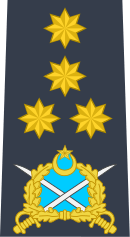 |
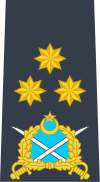 |
 |
 |
 |
 |
 |
 |
 |
 |
.png) | ||||||||||||||||||||||||
| Marshal of the Pakistan Air Force | Air Chief Marshal | Air Marshal | Air Vice Marshal | Air Commodore | Group Captain | Wing commander | Squadron Leader | Flight Lieutenant | Flying Officer | Pilot Officer | Officer Cadet | |||||||||||||||||||||||||
| Abbreviation | MAF | ACM | AM | AVM | Air Cdre | Gp Capt | Wg Cdr | Sqn Ldr | Ft Lt | F Off | P Off | |||||||||||||||||||||||||
| Pay grade | O-11 | O-10 | O-9 | O-8 | O-7 | O-6 | O-5 | O-4 | O-3 | O-2 | O-1 | |||||||||||||||||||||||||
- Structure of enlisted ranks:
| Equivalent NATO Code | OR-9 | OR-8 | OR-7 | OR-6 | OR-5 | OR-4 | OR-3 | OR-2 | OR-1 | |||||||||||||||||||||||||||
|---|---|---|---|---|---|---|---|---|---|---|---|---|---|---|---|---|---|---|---|---|---|---|---|---|---|---|---|---|---|---|---|---|---|---|---|---|
(Edit) |
 |
 |
 |
 |
No equivalent |  |
 |
 |
 |
 | ||||||||||||||||||||||||||
| Chief Warrant Officer | Warrant Officer | Assistant Warrant Officer | Senior Technician | Corporal Technician | Junior Technician | Senior Aircraftsman | Leading Aircraftsman | Aircraftsman | ||||||||||||||||||||||||||||
| Abbreviation | CWO | WO | AWO | Snr Tech | – | Cpl Tech | Jnr Tech | SAC | LAC | AC | ||||||||||||||||||||||||||
| Pay grade | OR-9 | OR-8 | OR-7 | OR-6 | – | OR-4 | OR-3 | OR-2 | OR-2 | OR-1 | ||||||||||||||||||||||||||
- Civilian occupations
- Gazetted Officer
- Steganographer
- Stenotypist
- Warehouse and Factory Personnel
- Clerk
Special forces
The Pakistan Air Force's Special Services Wing (SSW) is the branch's elite special operations fighting force. Originally coming into existence following the Indo-Pakistani War of 1965, the SSW is heavily modelled off of the United States Air Force's Special Tactics Squadrons with some elements inspired by the United States Army Rangers. The unit remained active but saw little prioritization by the Pakistani military until after the Kargil War. In late-1999, the SSW was largely revived and restructured for active service and is currently fielding around 1,200 troops.
Women in the Pakistan Air Force
No nation can ever be worthy of its existence that cannot take its women along with the men. No struggle can ever succeed without women participating side by side with men. There are two powers in the world; one is the sword and the other is the pen. There is a great competition and rivalry between the two. There is a third power stronger than both, that of the women.[73]
— Quaid-e-Azam Muhammad Ali Jinnah, c. 1947–1948
In its early history, women had been employed by Pakistan's armed forces—albeit in non-combat roles only. It was commonplace to find women serving in service branches such as the medical corps (as nurses or in other similar disciplines).[74] Aside from these exceptions, the Pakistan Air Force (PAF) had remained strictly all-male throughout its history, and women (as well as male youths under the age of 18) were prohibited from being deployed for combat, despite Muhammad Ali Jinnah's contradictory views on the subject upon Pakistan's independence.[75] However, since 2003, women have been allowed to enrol in the aerospace engineering program and others at the PAF Academy in Risalpur—including fighter pilot training programmes.[74][76] It has been stated that physical and academic standards are not compromised or exploited to favour women, and those who do not achieve the same performance as their male counterparts are immediately dropped from the course, however the level of enforcement of this rule is unknown. Within the structure of the PAF, a level of segregation between the genders is maintained in line with traditional views. For example, early-morning parades are performed together but some parts of training—mainly physical exercises—are done with males and females separated. According to Squadron Leader Shazia Ahmed, the officer in charge of the first female cadets in the PAF and a psychologist, this seems to improve the confidence levels of women.[77]
In 2005, it was reported that two batches in the PAF Academy's flying wing contained at least ten women, with many more in the engineering and aerospace wings. One such woman—Cadet Saba Khan from Quetta, Balochistan—applied after reading a newspaper advertisement stating that the PAF was seeking female cadets. She was one of the first four women to pass the first stages of flying training on propeller-driven light aircraft and move onto faster jet-powered training aircraft.[77]
In March 2006, the PAF officially inducted a batch of 34 fighter pilots which included the organization's first four female fighter pilots. Three years of training had been completed by the pilots at PAF Academy - Risalpur before they graduated and were awarded their Flying Badges during the ceremony. Certificates of honour were handed to the successful cadets by General Ahsan Saleem Hayat, then the vice-chief of the Pakistan Army, who acknowledged that the PAF was the first branch of the Pakistani military to introduce women to its combat units. One of the women, Flying Officer Nadia Gul, was awarded a trophy for best academic achievement. The other female graduates were Mariam Khalil, Saira Batool and the above-mentioned Cadet Saba Khan.[74] A second batch of pilots, including three female pilots, graduated from the 117th GD(P) course at PAF Academy - Risalpur in September 2006. The Sword of Honour for best all-round performance was awarded to Aviation Cadet Saira Amin, the first female pilot to win the award. Aviation Cadet Saira Amin also had won the Asghar Hussain Trophy for best performance in academics.[78]
In September 2009, it was reported that seven women had qualified as operational fighter pilots on the Chengdu F-7, the first female combat pilots to do so in the PAF's history. Commanding Officer Tanvir Piracha emphasized that if the female pilots "are not good enough as per their male counterparts, we don't let them fly." It was noted that some of the female pilots wear the hijab while others do not, as it is an optional exception to uniform standards should the woman wish to don one.[79]
Religious minorities in the Pakistan Air Force
Since its inception, religious minorities have been free to pursue careers within the Pakistan Armed Forces, with Hindu as notable exception until 2001. Following its involvement in the global U.S.-led War on Terror, Pakistan released the Hindu minority in the country from the discriminatory law and granted them the same freedoms that were given to their Christian, Sikh and other various counterparts.[80] Some notable religious minority figures in the Pakistan Air Force include: Air Vice Marshal Eric Gordon Hall, a Christian who served as the Base Commander of Chaklala Air Base during the Indo-Pakistani War of 1965. Air Commodore Nazir Latif and Group Captain Cecil Chaudhry (both Christians) fought in the Indo-Pakistani War of 1965 and later helped establish the Combat Commanders School (CCS). Wing Commander Melvin Leslie Middlecoat was the Commanding Officer of No. 9 Squadron during the 1965 war, he and Squadron Leader Peter Christy fought and were KIA in the Indo-Pakistani War of 1971. Patrick Desmond Callaghan was another Christian officer who rose to the rank of Air Vice Marshal.[81] Wing Commander Ronald Felix has been a notable pilot to first fly the jointly-built Chinese and Pakistani JF-17 Thunder fighter jet since 2010 and was one of two PAF pilots flying the JF-17 at the 2011 Izmir Air Show in Turkey.
Notable personnel
List of air chiefs
Notable awards for valour
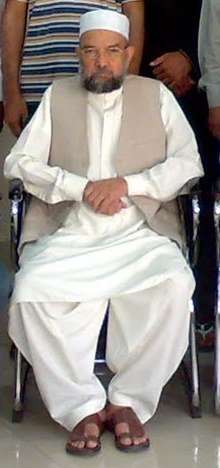
The Nishan-e-Haider (Urdu:نشان حیدر – lit: "Mark of Ali"), is the highest military award of Pakistan, and is roughly equivalent in value to the United States' Medal of Honor. Pilot Officer Rashid Minhas (1951 – 20 August 1971) is the only officer of the PAF to have been awarded the Nishan-e-Haider for sacrificing his life to save an aircraft from being hijacked to India.[82]
Other notable recipients of major military awards include:
- Air Commodore Muhammad Mahmood Alam – awarded for downing nine fighters[83] (five in a minute[84][85][86][87][88]) of the Indian Air Force in direct air-to-air combat.[89] (Sitara-e-Jurat)
- Squadron Leader Sarfaraz Ahmed Rafiqui – awarded for refusing to abandon his group of fighters during a battle despite his guns being jammed. He continued his attempts to assist his squadron in the battle by chasing enemy fighters until eventually being shot down.[90] (Hilal-e-Jurat, Sitara-e-Jurat)
Aircraft
Current inventory

.jpg)
%2C_Pakistan_-_Air_Force_AN1084290.jpg)
.jpg)
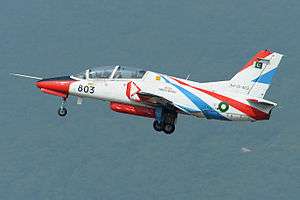
Combat aircraft
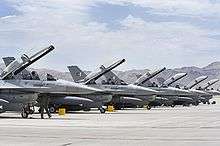
- General Dynamics F-16 Fighting Falcon: The F-16 Fighting Falcon currently serves as the primary air fighter of the Pakistan Air Force (PAF) in addition to its ground attack capabilities. The PAF currently has ~75 F-16s in active service, comprising 44 F-16AM/BM Block 15 MLU,[97][98][99] 13 F-16A/B ADF[100][101] and 18 F-16C/D Block 52+ variants.[102]
- CAC/PAC JF-17 Thunder: A multirole combat aircraft produced by Pakistan with Chinese assistance, the JF-17 was developed to replace Pakistan's aging fleets of A-5, F-7 and Mirage aircraft. Currently, 112 JF-17s are in active service with the PAF, comprising 50 Block I and 62 Block II variants.[103] A further 50 aircraft of the Block III model, incorporating advanced avionics systems and a new AESA radar, are expected to be produced. In addition the PAF is also expected to order 26 of the two-seat JF-17B variant.[104] The JF-17 is set to become the "backbone" of the PAF alongside its fleet of American F-16s.
- Dassault Mirage III: Having been in service since 1967, the Mirage III (together with the Mirage 5) serves as the primary strike aircraft of the PAF. The PAF operates more than 80 Mirage III aircraft, comprising multiple variants including the Mirage IIIEP, IIIEL and IIIO fighter-bomber variants, the Mirage IIIRP reconnaissance variant and the Mirage IIIBE, IIID, IIIDL and IIIDP training variants, all of which have been upgraded under a PAF program: Project ROSE.[105][106]PAF Chengdu F-7PG in flight.
- Dassault Mirage 5: The PAF operates around 90 Mirage 5 aircraft of multiple variants, including the Mirage 5PA, PA2, PA3 and 5F ground attack aircraft, the Mirage 5DR reconnaissance variant and the Mirage 5DD and DPA2 training variants.[105][106]
- Chengdu F-7: The Chengdu F-7 serves primarily as an interceptor, and around 140 aircraft are in service.[107] The PAF has phased out most of its F-7P aircraft from active service, with the remaining aircraft set to be replaced by the JF-17 Thunder in the coming years. The F-7PG variant remains the primary variant to remain in service with the PAF, while the two seat FT-7P and FT-7PG variants are in use as operational conversion trainers.
Special mission aircraft
- Saab 2000: The PAF has been operating the Saab 2000 using the Erieye radar as its primary AEW&C platform since 2009. Out of the original four Saab 2000 in service, one was destroyed and two were damaged in a Taliban attack on PAF Base Minhas in August 2012. The damaged aircraft were subsequently repaired and put back into service. The PAF had ordered three more Erieye AEW&C aircraft from Saab with the first batch having been delivered in 2017.[108]
- Shaanxi Y-8: Four ZDK-03 variants, locally designated as the Karakoram Eagle, are also in service. These incorporate a Chinese AESA radar mounted on a Y-8F-600 airframe.[109]
- Dassault Falcon 20: The PAF operates three modified Dassault Falcon 20 aircraft with a primary role in electronic warfare.
Transport aircraft
- Lockheed C-130 Hercules: The C-130 Hercules has served as the backbone of the PAF's transport fleet since its induction in 1962. 15 aircraft, five C-130Bs, nine C-130Es and one L-100, are currently in service. PAF C-130s have been upgraded with Allison T56-A-15 turboprops and extended fatigue lives.[110][111]
- CASA/IPTN CN-235: The PAF operates three CN-235-220 STOL transporters as medium transport, in addition to one aircraft equipped for VIP transport operations.
- Harbin Y-12: Three Harbin Y-12 are operated as light utility aircraft by the PAF.
- Gulfsteam IV: The PAF currently operates two Gulfstream IV-SP variants.
- Embraer Phenom 100: Approximately four of these aircraft are in service with the PAF for transportation purposes.
- Cessna Citation Excel: Currently, only one of these aircraft are used by the PAF.
_Pakistan_Air_Force.jpg)
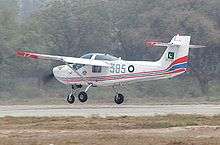
Aerial refuelling aircraft
- Ilyushin Il-78: The PAF operates four Il-78MPs equipped with UPAZ refuelling pods, procured from Ukraine, as aerial refuelling tankers. The Il-78 can also be used as a general transporter by removing the refuel tanks from the cargo hold.[113]
Trainer aircraft
- PAC MFI-17 Mushshak: The Mushshak serves as the PAF's basic trainer. The PAF operates 120 Mushshak aircraft, including the improved Super Mushshak variant.
- Cessna T-37 Tweet: The PAF has operated the T-37 as a basic jet trainer since 1962, and these have been supplemented over the years with additional aircraft from Turkey and the United States.[114]
- Hongdu JL-8: The K-8 is operated as an intermediate trainer, before cadets move on to conversion trainers. The K-8 is also operated by the PAF's aerobatics display team, the Sherdils.
- Shenyang J-6: A small number of FT-6s remain in service as jet trainers.
Helicopters
- Aérospatiale Alouette III: The Alouette III served as the PAF's primary search and rescue platform since the 1960s, also serving as a liaison aircraft.
- AgustaWestland AW139: Beginning in 2018, the PAF started inducting the AW139 to replace the venerable Alouette. The first AW139 unit became operational in March of that same year.[115][116]
- Mil Mi-17: The PAF also operates the Mi-171, which serves primarily in CSAR roles.[116]
Air defence systems
- MBDA Spada 2000 – A medium altitude air defence system consisting of a radar with range a range of 60 kilometres and four 6-cell missile launchers that can intercept enemy missiles and aircraft at a range of over 20 kilometres. A contract for ten batteries was signed when Aspide was selected over competing systems from Raytheon, Diehl BGT and Saab AB after pre-contract firing tests in Pakistan with assistance from the Italian Air Force.[117] Reports state that Pakistan tested the air defence system in July 2010, following deliveries of the first few batteries. Deliveries of all ten batteries are reported to have been completed in 2013 with further orders possible upon immediate request.[118] The missile system was tested by the Range & Instrumentation Division of SUPARCO in synergy with the PAF. Three drones were successfully intercepted and shot down by the missile system following extensive testing. With the procurement of the Spada 2000, Pakistan reportedly decommissioned most of its Crotale short-range air defence missile systems.[119]
- HQ-2 – The PAF extensively uses a Chinese adaptation of the Soviet S-75 Dvina high altitude air defence system, with reportedly 12 or more batteries procured in the 1970s.
- HQ-9 – In October 2003, it was reported that China had closed a deal with Pakistan to supply an unspecified number of FT-2000 systems, an anti-radiation variant of the HQ-9 long-range air defence system.[120] However, in March 2009, a report was published stating that Pakistan was not considering importing the missile.[121] It was reported in mid-2008 that Pakistan intended to purchase a high altitude air-missile defence system and the FD-2000, another variant of HQ-9, was expected to be chosen.[119][122]
- AML HE 60-20: A modified version of the French Panhard armoured vehicle equipped with a 20mm anti-aircraft cannon used primarily for on-base security.[123] At least five were originally in service in the late 1990s.[124][125]
Drone technology
On 7 September 2015, Pakistan became the ninth nation globally to develop and use an armed unmanned combat aerial vehicle (drone), the NESCOM Burraq. Pakistan first started exploring drone technology when it acquired Falco drones from Selex Galileo for approximately $40 million in 2008. Since then, Pakistan has been developing variants of the original Falco drone in the Pakistan Aeronautical Complex (PAC) in collaboration with the Italian firm. The Burraq was developed which was based on the Falco's technology. By March 2015, Pakistan was able to test-fire Burraq armed with an air-to-surface missile named Barq with pin-point precision. Burraq drones were used extensively to provide support to the Pakistan Army during Operation Zarb-e-Azb.[126]
Modernization and acquisitions
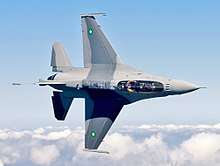
_inflight.jpg)
For a brief period, the Pakistan Air Force experienced a stall in modernization efforts, however this ended in April 2006 when the Pakistani cabinet approved the PAF's proposals to procure new aircraft and systems from several sources, including modern combat aircraft from the United States and China. The AFFDP 2019 (Armed Forces Development Programme 2019) would oversee the extensive modernization of the PAF from 2006 to 2019.[127]
On 24 July 2008, the Bush administration informed the U.S. Congress that it planned to shift nearly $230 million of $300 million in aid from counter-terrorism programs to upgrading Pakistan's ageing F-16s.[128] The administration had previously announced on 27 June 2008 that it was proposing to sell ITT Corporation's electronic warfare gear valued at up to $75 million to enhance Pakistan's existing inventory of F-16s.[129] Pakistan has asked about buying as many as 21 AN/ALQ-211(V)9 Advanced Integrated Defensive Electronic Warfare Suite Pods (AIDEWS) as well as other related equipment.[130] The proposed sale will ensure that the existing fleet is "compatible" with new F-16 Block 50/52 fighters being purchased by Islamabad.
After 9/11, the U.S. and Pakistan began discussing the release of the embargoed F-16s and Pakistan's ability to purchase new aircraft. Of the 28 F-16A/B built under the Peace Gate III/IV contracts and embargoed in 1990, 14 were delivered as EDA (Excess Defense Articles) from 2005 to 2008,[131] two of which were delivered on 10 July 2007.[132]
Between 2005 and 2008, 14 F-16A/B Block 15 OCU fighters were delivered to the PAF under renewed post-9/11 ties between the U.S. and Pakistan. These had originally been built for Pakistan under the Peace Gate III/IV contracts but were never delivered due to the subsequent U.S. arms embargo imposed on Pakistan in 1990.[133]
To upgrade the F-16A/B fleet, 32 Falcon STAR kits were purchased for the original Peace Gate I aircraft and 35 Mid-Life Update (MLU) kits were ordered, with 11 more MLU kits optional. Four F-16A/B being upgraded in the U.S. to F-16AM/BM had an expected delivery date of December 2011.[131] F-16A/B in the PAF's service were to be upgraded starting in October 2010 by Turkish Aerospace Industries, at a rate of one per month.[134][135]
The Peace Drive I contract for 12 F-16C and six F-16D Block 52+ (Advanced Block 52) aircraft, powered by F100-PW-229 engines was signed on 30 September 2006.[136][137] The first F-16 to be completed, an F-16D, was rolled out on 13 October 2009 and began flight testing immediately.[138][139][140][141][142] The first batch of F-16C/D Block 52+, two F-16D and one F-16C landed at PAF Base Shahbaz, Jacobabad, on 26 June 2010.[143][144][145] One more F-16C was received by 5 July 2010.[146]
On 13 December 2008, the Government of Pakistan stated that two Indian Air Force aircraft were intercepted by the Pakistan Air Force a few kilometres inside Pakistani airspace. This charge is denied by the Indian government.[147]
During talks with a delegation from the French Senate on 28 September 2009, Prime Minister Yousuf Raza Gilani stated that the PAF had used most of its stockpile of laser-guided munitions against militants in the Malakand and FATA regions and that replacements for such types of equipment were urgently required.[148]
In December 2009, Pakistan saw the delivery of the PAF's first Saab 2000 Erieye AEW&C from Sweden and an Il-78MP aerial refuelling tanker/military transport aircraft from Ukraine.[149][150][151]
The PAF was reported to be considering purchasing the Chinese Hongdu L-15 advanced jet trainer to train pilots for high-tech fighters such as the FC-20. Extensive evaluations of the aircraft took place in Pakistan in December 2009.[152][153]
According to Air Chief Marshal (ACM) Rao Qamar Suleman (then Chief of Air Staff), the new fighters would eliminate the PAF's limitations in conducting precision night-time strike operations,[154] as the existing capability was based on around 34 Dassault Mirage 5 fighters upgraded with new avionics for night-time precision strike missions under the Retrofit of Strike Element (ROSE) programme during 1999–2004.[155][156][157] The SABIR (Special Airborne Mission Installation & Response System), a FLIR system that has Brite Star II and Star Safire III EO/IR sensors installed on a C-130 saw extensive usage during the Pakistani military's operations against militants in the FATA region.
Planned acquisitions
Mass production of the PAC JF-17 Thunder A Block-3, a 4.5 generation aircraft, is underway to replace the F-16 as the "backbone" of the Pakistan Air Force's arsenal. After every 3–5 years, newer blocks of the aircraft are expected to be produced. Pakistan has been in extensive talks with China to acquire between 40 to 60 upgraded fifth-generation Shenyang FC-31 stealth fighter aircraft (J-31 for short). The TAI TF-X, another fifth-generation aircraft under development by Turkey (intended to operate with critical assets such as the American F-35 Lightning II) has also been a viable offer for Pakistan, as these fighters can greatly strengthen the PAF's fleet before the country's own fifth-generation fighter is developed under Project Azm. Pakistan is also reportedly working on developing a strong arsenal of UAVs alongside China, based off of the designs of the CAIG GJ-2 MALE-UCAV.[158]
Project Azm
On 7 July 2017, the Pakistan Air Force announced the development of a fifth-generation fighter aircraft, a medium-altitude long-endurance unmanned aerial vehicle (MALE UAV) and munitions under the banner of Project Azm (Urdu for resolve/determination).[159][160][161][162][163] Air Chief Marshal (ACM) Sohail Aman stated that the design phase for the MALE UAV was in its final stages.[159][163]
Military exercises
The Pakistan Air Force sent a contingent of six F-16A/B fighters to the 2004 international Anatolian Eagle exercise in Turkey.[164][165]
In 2005, after around one year of planning, the PAF held the High Mark 2005 military exercise which lasted for one month and also involved the Pakistan Army and Pakistan Navy. The scenario saw two opposing forces, Blueland and Foxland, engaging in simulated combat which involved both offensive and defensive operations. It was stated that the exercise would consist of three stages and PAF aircraft would fly around 8200 sorties. The involvement of units from the Pakistan Army and Navy was aimed at providing more realistic operational scenarios. High Mark 2005 followed the Tempest-1 military exercise which was focused purely on air power but differed in terms of the duration, intensity and complexity of all air operations being conducted.[166]
In 2008, the Turkish Air Force sent five F-16C/D fighters and 50 personnel from 191 Cobras Squadron to Pakistan to take part in the joint Indus Viper exercise at PAF Base Mushaf.[165]
In the summer of 2005, a PAF team of 20 airmen, including pilots, navigators, engineers, maintenance technicians and a C-130E was sent to the United States to take part in the AMC (Air Mobility Command) Rodeo.[167] The PAF again took part in the AMC Rodeo two years later, in July 2007.[168][169]
In 2009, while undertaking combat operations against militants in the FATA and Swat regions, the PAF initiated the Saffron Bandit exercise with the aim of training the PAF's entire combat force to undertake such anti-terrorist operations.[170][171]
In December 2009, the PAF sent six Chengdu F-7PG fighters of No. 31 Wing based at PAF Base Samungli to the United Arab Emirates to take part in the Air Tactics Leadership Course (ATLC)—also known as Exercise Iron Falcon—at Al Dhafra Air Base.[172][173][174]
The PAF's High Mark 2010 exercise was launched on 15 March 2010, the first time a High Mark exercise had been conducted since 2005, after all PAF received their Air Tasking Orders (ATO). The country-wide exercise involved units based all over Pakistan, from Skardu to the Arabian Sea, at all Main Operating Bases and Forward Operating Bases. Joint operations involving the Pakistan Army and Pakistan Navy were also conducted, aiming to test and improve integration and co-operation between the three branches of the Pakistan Armed Forces. Operations emphasized a near-realistic simulation of a wartime environment, exposure of PAF aircrews to contemporary concepts of air combat, new employment concepts and joint operations between the Pakistan Air Force, Army and Navy. New inductions such as the JF-17 Thunder, Saab 2000 Erieye AEW&C and Il-78 MRTT also saw service in this exercise.[175] On 6 April 2010, the end of the first phase of exercise High Mark 2010 was celebrated with a 90-minute firepower demonstration at the PAF's firing range facility in the deserts of Thal. The H-2 SOW was also shown to the public for the first time, being launched from around 60 km away before hitting its target, and a mock counter-insurgency operation was performed by participating forces. The demo heralded the beginning of High Mark 2010's second phase, where the PAF would practice joint operations with the Pakistan Army during the its own exercise Azm-e-Nau-3 (New Resolve 3).[176] During High Mark 2010, a Chengdu F-7 and Mirage 5 fighter practiced landing, refuelling and take-off operations from a motorway. It was reported that the PAF is in negotiations with the Ministry of Communications to set up any required facilities for PAF operations on various motorways in Pakistan.[177][178]
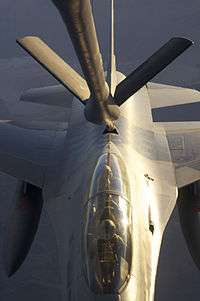
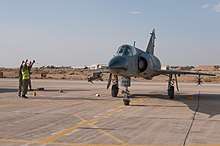
In July 2010, the PAF sent six F-16B fighters of No. 9 Griffins Squadron and 100 PAF personnel to Nellis Air Force Base in the U.S. to participate in the international Red Flag exercise for the first time. During the exercise, the PAF pilots practiced in-flight refuelling with their F-16s using the Boeing KC-135 Stratotanker.[179][180][181][182][183]
In October 2010, the PAF's No. 7 Bandits Squadron sent a team of its Dassault Mirage III ROSE fighters to Jordan to participate in the Falcon Air Meet 2010 exercise at the Azraq Royal Jordanian Air Base.[184][185] January 2011 saw a PAF contingent of F-16A/B and Dassault Mirage fighters take part in the Al-Saqoor II exercise in Saudi Arabia with the Royal Saudi Air Force.[186][187][188]
In March 2011, a joint Sino-Pakistani exercise, codenamed Shaheen-1, was conducted involving a contingent of Chinese aircraft and personnel from the PLAAF.[189] Information on which aircraft were used by each side in the exercise remained classified, but photos of Pakistani pilots inspecting what appeared to be Chinese Shenyang J-11B fighters were released on the internet. The exercise lasted for around four weeks and was the first time the PLAAF had deployed to Pakistan and conducted "operational" aerial manoeuvres with the PAF.[190]
Involvement in Pakistani society
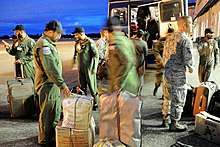
The Pakistan Air Force, alongside other branches of the armed forces has played an integral part in the civil society of Pakistan since its inception.[191] In 1996, General Jehangir Karamat described the Pakistani military's relations with Pakistan's populace:
In my opinion, if we have to repeat of past events then we must understand that military leaders can pressure only up to a point. Beyond that their own position starts getting undermined because the military is after all is a mirror image of the civil society from which it is drawn.
— General Jehangir Karamat on civil society–military relations, [191]
In times of natural disaster such as the chaotic floods of 1992 or the October 2005 earthquake, PAF engineers, medical and logistics personnel alongside the rest of the armed forces played a major role in bringing relief aid and supplies to those who were affected.[192]
In addition to the PAF's involvement in relief activities at home, it has also helped the Pakistani military's responses to natural disasters in many other countries globally.[192] The PAF was involved in the dispatching of relief to Indonesia, Bangladesh and Sri Lanka after they were hit by the 2004 Indian Ocean earthquake and tsunami. Coordinating a synergized response, the Pakistan Armed Forces sent ships and helicopters with aid and personnel to assist in the international relief operation.[192]
In popular culture
In Pakistani literature, the shaheen falcon has a special association with the poetry of the country's national poet, Allama Muhammad Iqbal.[193] The bird also appears on the official representative badge of the Pakistan Air Force.
Various Urdu-language drama serials on the PAF have been written, produced, directed, and televised nationwide. Notable Urdu drama serials and films involving the PAF are Shahpar and Sherdil, which were televised on PTV and ARY Digital, respectively.[194]
See also
- Pakistan Armed Forces
- Air Force Strategic Command
- Pakistan Air Force Museum
- Pakistan Aeronautical Complex
- China-Pakistan military relations
- Pakistan-United States military relations
References
- Barvarz, Fartash (2012). Islamic Atomic Bomb (google books) (1st ed.). Bloomington, Indiana, U.S.: AuthorHouse. p. 116. ISBN 9781426923661. Retrieved 10 February 2019.
- Iqbal, Saghir (2018). "(§Air Force)". Pakistan's War Machine (Google books (Paperback)) (1st ed.). New York, U.S.: CreateSpace Independent Publishing Platform. p. 366. ISBN 9781986169424. Retrieved 10 February 2019.
- "Air Force Civilians". paf.gov.pk. ISPR Air Force. Archived from the original on 8 July 2018. Retrieved 12 February 2019.
- File:Pakistan Air Force Official Logo White Background.jpg
- The International Institute of Strategic Studies (14 February 2017). The Military Balance 2017. Routledge, Chapman & Hall, Incorporated. ISBN 9781857439007.
- "WorldAirForces2019.pdf". Flightglobal. Retrieved 8 December 2019.
- PAF. "History of PAF". AIr Force ISPR. Archived from the original on 15 December 2011. Retrieved 28 November 2014.
- "Article 243". Archived from the original on 5 February 2012. Retrieved 18 January 2013.
- "Air Chief Marshal Mujahid Anwar takes over command of PAF". 19 March 2018. Archived from the original on 19 March 2018. Retrieved 19 March 2018.
- History of the Pakistan Air Force 1947–1982, Pakistan Air Force Book Club, 1982
- Fricker, John (1969), "Pakistan's Air Power", Flight International, p. 89, archived from the original on 14 January 2012, retrieved 21 September 2009
- Fricker, John (1969), "Pakistan's Air Power", Flight International, p. 90, archived from the original on 12 January 2012, retrieved 21 September 2009
- "1965 war: We achieved air superiority in three days, says Air Force Marshal Arjan Singh". 4 October 2015. Archived from the original on 14 June 2016. Retrieved 3 August 2016.
- "Pakistan's Air Power", Flight International, issue published 5 May 1984 (page 1208). Can be viewed at FlightGlobal.com archives, URL: http://www.flightglobal.com/pdfarchive/view/1984/1984%20-%200797.html?search=F-86%20Pakistan Archived 12 January 2012 at the Wayback Machine. Retrieved 22 October 2009
- Faruqui, Ahmad (14 September 2009). "The right stuff". Dawn News. Archived from the original on 29 March 2010. Retrieved 8 February 2016.
- Werrell, Kenneth (2013). Sabres Over MiG Alley: The F-86 and the Battle for Air Superiority in Korea. Naval Institute Press. p. 188. ISBN 9781612513447.
- Fricker, John. Battle for Pakistan: the air war of 1965. pp. 15–17. before we had completed more than of about 270-degree of the turn, at around 12-degree per second, all four hunters had been shot down ... My fifth victim of this sortie started spewing smoke and then rolled on to his back at about 1000 feet.
- Chris Smith; Stockholm International Peace Research Institute (1994). India's Ad Hoc Arsenal: Direction Or Drift in Defence Policy?. Oxford University Press. p. 85. ISBN 978-0-19-829168-8.
- Edward V. Coggins; Ed Coggins (2000). Wings That Stay on. Turner Publishing Company. p. 164. ISBN 978-1-56311-568-4. Archived from the original on 7 January 2016. Retrieved 15 November 2015.
- Mike Spick (2002). The Illustrated Directory of Fighters. MBI Publishing Company LLC. p. 161. ISBN 978-0-7603-1343-5. Archived from the original on 7 January 2016. Retrieved 15 November 2015.
- Harry, B. (2 September 2006). "IAF combat kills - 1965 Indo-Pak Air War" (PDF). Order of Battle web site (orbat.com). Archived from the original (PDF) on 27 November 2010. Retrieved 29 December 2011.
- Archived 5 November 2006 at the Wayback Machine
- Thomas M. Leonard (2006). Encyclopedia of the developing world. Taylor & Francis. p. 806. ISBN 978-0-415-97663-3. Retrieved 14 April 2011.
- "Indo-Pakistan Wars". Archived from the original on 8 May 2009.
- Coggins 2000, pp. 163–164.
- Sisson & Rose 1991, p. 229
- Jagan Pillarisetti. "Boyra Encounter – 22nd November 1971". Bharat Rakshak. Archived from the original on 18 November 2011. Retrieved 19 January 2012.
- "Newsweek : the international newsmagazine: US edition". Newsweek: 34. 20 December 1971. ISSN 0028-9604.
Trying to catch the Indian Air Force napping, Yahya Khan, launched a Pakistani version of Israel's 1967 air blitz in hopes that one quick blow would cripple India's far superior air power. But India was alert and Yahya's strategy of scattering his thin air force over a dozen air fields failed!
- Kainikara 2011, p. 195
- M. Leonard, Thomas (2006). Encyclopedia of the Developing World. Taylor & Francis. p. 806. ISBN 978-0415976640. Retrieved 13 July 2015.
- Khan, Iftikhar A. (28 May 2010). "Threat to destroy Indian N-plant stopped attack on Kahuta". Dawn. Pakistan: The Dawn Media Group. Archived from the original on 30 May 2010. Retrieved 28 May 2010.
- Shamim, M. Anwar (2010). Cutting Edge PAF: A Former Air Chief's Reminiscences of a Developing Air Force. Vanguard Books. ISBN 978-969-402-540-7.
- "HISTORY OF PAF". Pakistan Air Force. Archived from the original on 15 December 2011. Retrieved 20 December 2011.
- "F16 Air Forces – Pakistan". F-16.net. Archived from the original on 29 May 2011. Retrieved 8 June 2011.
- John Pike. "F-16 Fighting Falcon". Globalsecurity.org. Archived from the original on 24 August 2011. Retrieved 8 June 2011.
- "PAF F-16 squadron pilots & crew during Soviet/Afghan War 1979–1988". Archived from the original on 6 January 2012. Retrieved 14 January 2012.
- Archived 15 January 2012 at the Wayback Machine. PAF F-16 air kills illustrations.
- F-16 Air Forces – Pakistan Archived 23 July 2009 at the Wayback Machine. F-16.net. Retrieved 8 September 2010.
- "Doubts crop up about F-16 Fighting Falcon's capabilities after PAF mishap".
- "Pakistan evaluates fighters", Air International, p. 950, 4 April 1981, archived from the original on 12 January 2012, retrieved 6 May 2020
- How China keeps the PAF flying Archived 28 July 2011 at the Wayback Machine. Southasiaanalysis.org. Retrieved 8 September 2010.
- "lockheed | Flight Archive". Flightglobal. 2 June 1992. Archived from the original on 12 January 2012. Retrieved 8 June 2011.
- "1994 | Flight Archive". Flightglobal. 23 August 1994. Archived from the original on 3 March 2012. Retrieved 8 June 2011.
- "McDonnell Douglas Flight Archive". Flightglobal. 18 October 1994. Archived from the original on 14 January 2012. Retrieved 8 June 2011.
- "1994 Flight Archive". Flightglobal. 29 November 1994. Archived from the original on 13 January 2012. Retrieved 8 June 2011.
- "The Getaway". Archived from the original on 2 February 2019. Retrieved 21 January 2019.
- "Context of 'November 14–25, 2001: US Secretly Authorizes Airlift of Pakistani and Taliban Fighters'". Archived from the original on 4 November 2018. Retrieved 21 January 2019.
- "Mukherjee denies making phone call to Zardari". Paktribune.com. Archived from the original on 3 June 2013. Retrieved 28 November 2012.
- Nelson, Dean (23 March 2011). "WikiLeaks: hoax phone call brought India and Pakistan to brink of war". The Daily Telegraph. London. Archived from the original on 17 October 2018. Retrieved 2 April 2018.
- Nelson, Dean (23 March 2011). "WikiLeaks: hoax phone call brought India and Pakistan to brink of war". The Daily Telegraph. Archived from the original on 6 January 2016. Retrieved 30 March 2016.
- Patrick Cockburn in Lahore (7 December 2008). "Pakistan on full military alert after hoax call". The Independent. Archived from the original on 9 March 2016. Retrieved 30 March 2016.
- "Hoax Phone Call 'Almost Took Pakistan to War'". Common Dreams. Archived from the original on 4 March 2016. Retrieved 30 March 2016.
- "PAF detected US planes near Jalalabad border before OBL operation". The News. 9 May 2011. Archived from the original on 20 December 2014. Retrieved 20 December 2014.
- "Abbottabad commission visits PAF HQ". Dawn. Pakistan. 11 September 2011. Retrieved 28 November 2012.
- "Military failures revealed by Bin Laden raid". Al Jazeera. 10 July 2013. Archived from the original on 11 February 2018. Retrieved 11 February 2018.
- Sehgal, Ikram (8 April 2010). "Airpower in COIN operations". Newspaper article. The News (Jang Group) <http://www.thenews.com.pk>. Retrieved 8 April 2010.
- U.S. hopes to give Pakistan drones within a year Archived 23 November 2010 at the Wayback Machine. Reuters. Retrieved 8 September 2010.
- SCHMITT, ERIC (29 July 2009). "Pakistan Injects Precision into Air War on Taliban". Newspaper article. New York Times (www.nytimes.com). Archived from the original on 18 August 2011. Retrieved 8 April 2010.
- Guerin, Orla (14 April 2010). "Pakistan admits civilian deaths". BBC News. Retrieved 20 May 2010.
- "General Kayani apologises over civilian deaths". Dawn.com (online newspaper). Pakistan. 17 April 2010. Archived from the original on 20 April 2010. Retrieved 21 April 2010.
- "'Civilians die' in Pakistan raid". BBC News. 13 April 2010. Archived from the original on 8 August 2017. Retrieved 20 May 2010.
- Slater, Joanna (26 February 2019). "India strikes Pakistan in severe escalation of tensions between nuclear rivals". The Washington Post. Retrieved 15 April 2020.
- Islamabad, Michael Safi Mehreen Zahra-Malik in; Srinagar, Azhar Farooq in (27 February 2019). "'Get ready for our surprise': Pakistan warns India it will respond to airstrikes". The Guardian. ISSN 0261-3077. Retrieved 15 April 2020.
Pakistan, ... said the war planes made it up to five miles inside its territory
- Abi-Habib, Maria; Ramzy, Austin (25 February 2019). "Indian Jets Strike in Pakistan in Revenge for Kashmir Attack". The New York Times. ISSN 0362-4331. Retrieved 15 April 2020.
A spokesman for Pakistan’s armed forces, Maj. Gen. Asif Ghafoor, on Tuesday posted on Twitter four images of a forested area pockmarked with small craters and debris, which he said was the site of Indian airstrikes.
- "Pakistan shoots down two Indian fighter jets: Military". Al Jazeera. Archived from the original on 28 February 2019. Retrieved 28 February 2019.
- Dawn.com (27 February 2019). "2 Indian aircraft violating Pakistani airspace shot down; pilot arrested". Dawn. Pakistan. Archived from the original on 27 February 2019. Retrieved 28 February 2019.
- Pubby, Manu (28 February 2019). "Abhinandan Varthaman's MiG21 locked in Pakistan's F16". The Economic Times. Archived from the original on 28 February 2019. Retrieved 28 February 2019.
- "Pakistan says no F-16 aircraft used, dismisses report of their fighter jet crashing". businesstoday.in. Archived from the original on 27 February 2019. Retrieved 28 February 2019.
- Slater, Joanna; Constable, Pamela (28 February 2019). "Pakistan captures Indian pilot after shooting down aircraft, escalating hostilities". The Washington Post. Retrieved 15 April 2020.
- quraishi, omar r (27 February 2019). "PAF Sqaudron Leader Hasan Siddiqui upon his return to base from a successful mission where he shot down an IAF MiG 29pic.twitter.com/HxGP17fO9k". @omar_quraishi. Retrieved 28 February 2019.
- "PAF Active Bases" Archived 26 June 2010 at the Wayback Machine PAF Official Website. Retrieved 28 February 2010
- http://www.parc.gov.pk/index.php/en/quotes-of-quaid-e-azam "Quotes of Quaid-e-Azam Muhammad Ali Jinnah"
- Abbas, Zaffar (30 March 2006). "Pakistan gets women combat pilots". BBC News. Archived from the original on 27 February 2009. Retrieved 21 May 2011.
- "Quotes of Quaid-e-Azam". www.parc.gov.pk. Retrieved 16 May 2020.
- Ghori, Umaima. "The Sword, The Pen and The Women in Pakistan's Counter-Terrorism Efforts". NAOC. Retrieved 16 May 2020.
- Abbas, Zaffar (11 May 2005). "Pakistan's first women fighter pilots". BBC News. Islamabad. Archived from the original on 2 September 2007. Retrieved 21 May 2011.
- "Woman aviation cadet makes PAF hiory". Daily Times. Islamabad. 23 September 2006. Archived from the original on 7 June 2011. Retrieved 21 May 2011.
- "Pakistan's female fighter pilots break down barriers – CNN". CNN. 14 September 2009. Archived from the original on 13 February 2010. Retrieved 20 May 2010.
- "The White of the Flag: Contributions of Non-Muslims for National Defense of Pakistan". Centre for Strategic and Contemporary Research. 6 September 2017. Retrieved 14 May 2020.
- "The News International: Latest News Breaking, Pakistan News". The News International. Archived from the original on 18 October 2015. Retrieved 30 March 2016.
- PAKISTAN AIR FORCE – Official website Archived 14 March 2010 at the Wayback Machine. Paf.gov.pk. Retrieved 8 September 2010.
- Fighter Pilot Aces List Archived 1 March 2010 at the Wayback Machine. Au.af.mil. Retrieved 8 September 2010.
- "Alam's Speed-shooting Classic". Defencejournal.com. 6 September 1965. Archived from the original on 27 September 2011. Retrieved 15 November 2011.
- "PAKISTAN AIR FORCE – Official website". Paf.gov.pk. Archived from the original on 13 October 2011. Retrieved 16 November 2011.
- Fricker, John (1979). Battle for Pakistan: the air war of 1965. ISBN 9780711009295. Archived from the original on 6 January 2016. Retrieved 15 November 2015.
'before we had completed more than of about 270-degree of the turn, at around 12-degree per second, all four hunters had been shot down.'
- "Re-birth of Pakistan's Record-holder Air Fighter as a New Man: Mohmammad M. Alam". Yespakistan.com. Archived from the original on 17 November 2011. Retrieved 28 November 2012.
- "Pakistan – Not as seen on TV!". Ideasevolved.com. Archived from the original on 13 September 2012. Retrieved 28 November 2012.
- Alam's Speed-shooting Classic Archived 27 September 2011 at the Wayback Machine. Defencejournal.com (6 September 1965). Retrieved 8 September 2010.
- CITATION OF PAF SHAHEEDS – 1 Archived 21 February 2009 at the Wayback Machine. Defencejournal.com. Retrieved 8 September 2010.
- "World Air Forces 2020". Flightglobal Insight. 2020. Retrieved 10 March 2020.
- Pakistan to begin co-production of Falco UAV. Flightglobal. (26 August 2009). Retrieved 1 July 2012.
- . globalpost.com.
- Tactical Range UAV – Jasoos II (Bravo+) Archived 10 September 2012 at the Wayback Machine. Satuma.com.pk. Retrieved 1 July 2012.
- "IDEX: Explosion of UAVs at Exhibit". Defense News. 19 February 2013. Retrieved 14 April 2013.
- "Pakistan to begin co-production of Falco UAV". Flightglobal. 26 August 2009. Retrieved 10 March 2012.
- "Turkey to upgrade Pakistani F-16s". f-16.net. Retrieved 26 March 2020.
- "Turkey to upgrade PAF F-16s". The Nation. 11 December 2010. Retrieved 26 March 2020.
- "Turkish Aerospace to start Pakistani F-16 upgrades in 2010". Flightglobal. Archived from the original on 19 July 2010. Retrieved 8 June 2011.
- "Pakistan receives first five F-16s from Jordan". f-16.net. Retrieved 26 March 2020.
- "PAF acquires F-16s from Jordan". The News International. Retrieved 26 March 2020.
- "US delivers three F-16 jets to Pakistan". Dawn News. 26 June 2010. Archived from the original on 28 June 2010. Retrieved 26 June 2010.
- Gady, Franz-Stefan. "Pakistan Air Force to Receive Final Batch of JF-17 Block II Fighter Jets in June". thediplomat.com. Retrieved 26 March 2020.
- "JF-17 Block 3 Prototype Takes Flight". Quwa. 31 December 2019. Retrieved 26 March 2020.
- "Grande Strategy". archive.is. 24 November 2014. Retrieved 26 March 2020.
- Warnes, Alan (December 2013). "Pakistan's Amazing Mirages". Combat Aircraft Monthly. 14 (12): 56–63.
- "World Air Forces 2020". Flightglobal Insight. 2020. Retrieved 10 March 2020.
- "Pakistan to get more Erieyes | Air Forces Monthly". Retrieved 26 March 2020.
- Pakistan to get Chinese AEW&C aircraft this year Archived 10 May 2010 at the Wayback Machine. Flightglobal. Retrieved 8 September 2010.
- Photo gallery of C-130 Hercules in service with PAF. Archived 31 December 2011 at the Wayback Machine.
- "Rockwell Collins Awarded $30.7 Million Pakistani C-130 Upgrade Contract". defense-aerospace.com. Archived from the original on 23 March 2016. Retrieved 30 March 2016.
- Anis, Muhammad (7 April 2010). "PAF flexes its muscles". Newspaper article. Islamabad, Pakistan: The News (Jang Group, www.thenews.jang.com.pk). Retrieved 7 April 2010.
- "Pakistan Receiving IL-78 Refueling aircraft". Defense Industry Daily. Retrieved 26 March 2020.
- Haider, Mateen (28 October 2015). "Turkey to provide 34 T-37 aircraft to Pakistan free of cost". Dawn. Pakistan. Retrieved 26 March 2020.
- "PAF No. 88 Squadron Equipped With AgustaWestland AW139 Helicopters - History of PIA - Forum". historyofpia.com. Retrieved 26 March 2020.
- "AW139: The Pakistan Air Force's New Mainstay SAR Helicopter". Quwa. 22 October 2019. Retrieved 26 March 2020.
- MBDA Confirms Air Defense System Sale to Pakistan. Defense News. Retrieved 8 September 2010.
- Pakistan To Test-Fire Italy Air Defense Missiles. Defense News (7 April 2010). Retrieved 8 September 2010.
- Pakistan Targets Air Combat. Defense News (14 July 2008). Retrieved 8 September 2010.
- FT-2000 Archived 19 September 2008 at the Wayback Machine. MissileThreat. Retrieved 8 September 2010.
- Analysis: China exports new SAM missile Archived 22 March 2009 at the Wayback Machine. Spacewar.com. Retrieved 8 September 2010.
- "Pakistan May Seek Chinese Interceptor", Defense News www.defensenews.com
- Pakistan: Military takes security of Airports, Prisons and Defence Installations Archived 29 November 2014 at the Wayback Machine
- African Defence Journal: Article "Panhard Armoured Cars and Reconnaissance Vehicles in Africa". The Journal Publishers, 1981 volume, Collected Issues 5–16 p. 58.
- Bonsignore, Ezio, ed. (1993). World Defence Almanac 1992–93: The Balance of Military Power. Bonn: Monch Publishing Group. pp. 200–201. ISSN 0722-3226.
- Fazl-e-Haider, Syed (5 October 2015). "Islamabad Just Used Armed UAVs—Here's What It Means for the Region and World – Foreign Affairs". Foreign Affairs. Archived from the original on 2 February 2016. Retrieved 30 March 2016.
- "Pakistan to buy 98 hi-tech aircraft from US and China". Business Recorder. Archived from the original on 21 October 2012. Retrieved 8 June 2011.
- Schmitt, Eric (24 July 2008). "Plan Would Use Antiterror Aid on Pakistani Jets". The New York Times. Pakistan. Archived from the original on 6 April 2013. Retrieved 8 June 2011.
- "US eyes electronic-warfare sale to Pakistan". Reuters. 27 June 2008. Archived from the original on 24 February 2009. Retrieved 8 June 2011.
- "Pakistan – AN/ALQ-211(V)9 AIDEWS Pods". Asd-network.com. Archived from the original on 7 September 2009. Retrieved 8 June 2011.
- "Written Statement of" (PDF). Archived from the original (PDF) on 29 June 2011. Retrieved 8 June 2011.
- "Archive | Your Source of News on the World Wide Web". Dawn. Pakistan. 11 July 2007. Archived from the original on 5 February 2009. Retrieved 8 June 2011.
- Asia Times Online :: South Asia news – Pakistan heading for a crackdown Archived 8 April 2009 at the Wayback Machine. Asia Times Online. (13 July 2007). Retrieved 8 September 2010.
- "Turkish Aerospace Industries Inc". Tai.com.tr. 29 June 2009. Archived from the original on 27 May 2011. Retrieved 8 June 2011.
- Govindasamy, Siva. "Turkish Aerospace to start Pakistani F-16 upgrades in 2010". Flightglobal. Archived from the original on 19 July 2010. Retrieved 8 June 2011.
- "The News International: Latest News Breaking, Pakistan News". Retrieved 22 May 2011.
- "LOCKHEED MARTIN RECEIVES INITIAL $78 MILLION CONTRACT TO PRODUCE 18 NEW F-16s". Lockheedmartin.com. 11 December 2006. Archived from the original on 25 March 2008. Retrieved 8 June 2011.
- "Unveils First New F-16 For Pakistan in Ceremony Attended By Air Force Chiefs". Lockheed Martin. 13 October 2009. Archived from the original on 1 July 2011. Retrieved 8 June 2011.
- "Associated Press of Pakistan ( Pakistan's Premier NEWS Agency ) – Inauguration of first BLK-52 F-16D aircraft". App.com.pk. Archived from the original on 16 April 2015. Retrieved 8 June 2011.
- "Peace Drive I – First F-16 unveiled". F-16.net. Archived from the original on 6 September 2011. Retrieved 8 June 2011.
- "PICTURES: Lockheed Martin unveils first F-16 Block 52 ordered by Pakistan". Flightglobal. Archived from the original on 26 December 2010. Retrieved 8 June 2011.
- "Rah-e-Nijat and PAF's new F-16". The Nation. Pakistan. Archived from the original on 27 October 2009. Retrieved 8 June 2011.
- "US delivers three F-16 jets to Pakistan". Dawn News. 26 June 2010. Archived from the original on 28 June 2010. Retrieved 26 June 2010.
- "PAF gets three F-16s". Geo News website (www.geo.tv). Geo Television Network. 26 June 2010. Archived from the original on 29 June 2010. Retrieved 26 June 2010.
- "First batch of latest version of F-16 aircraft reaches Pakistan". APP website. Associated Press of Pakistan (APP). 24 June 2010. Archived from the original on 1 April 2012. Retrieved 29 June 2010.
- "Pakistan gets fourth F-16 jet". The Express Tribune. 5 July 2010. Archived from the original on 8 July 2010. Retrieved 10 July 2010.
- Pakistan, India row over 'violation' by fighter jets Archived 22 September 2011 at the Wayback Machine. News.asiaone.com (14 December 2008). Retrieved 8 September 2010.
- Pakistan|Laser-guided munition exhausted, says Gilani Archived 3 October 2009 at the Wayback Machine. Dawn.Com (29 September 2009). Retrieved 8 September 2010.
- Front Page|PAF gets mid-air refueller aircraft Archived 3 January 2010 at the Wayback Machine. Dawn.Com (20 December 2009). Retrieved 8 September 2010.
- Pakistan Receiving IL-78 Refueling aircraft Archived 15 April 2010 at the Wayback Machine. Defenseindustrydaily.com (8 December 2008). Retrieved 8 September 2010.
- "First aircraft tanker arrives in Pakistan: PAF". GEO.tv. 19 December 2009. Archived from the original on 16 April 2010. Retrieved 8 June 2011.
- Pakistan Eyes Acquisition of Chinese Training Aircraft. Defense News (1 February 2010). Retrieved 8 September 2010.
- "US-Pak air forces conduct joint refuelling operation". Daily Times. Pakistan. 5 March 2010. Archived from the original on 10 March 2010. Retrieved 5 March 2010.
- "PAF attains night time attack capability: PAF Chief". App.com.pk. Archived from the original on 1 April 2012. Retrieved 8 June 2011.
- Improvise and modernise-24 February 1999-Flight International. Flightglobal. (24 February 1999). Retrieved 8 September 2010.
- Top Story: New Fighter Squadron added to Pakistan Air Force. Pakistan Times. Retrieved 8 September 2010. Archived 7 July 2007 at the Wayback Machine
- PAF gets new Mirage fighter squadron – News – Webindia123.com Archived 18 July 2011 at the Wayback Machine. News.webindia123.com (20 April 2007). Retrieved 8 September 2010.
- Tyler Rogoway. "Pakistan Looking To Buy China's J-31 Stealth Fighter". Foxtrot Alpha. Archived from the original on 4 April 2016. Retrieved 30 March 2016.
- Khan, Bilal (6 July 2017). "Pakistan Announces 5th-Gen Fighter And Medium-Altitude Long-Endurance UAV Programs". QUWA. Retrieved 9 July 2017.
- Master, Web (6 July 2017). "PAF establishes Aviation City at Aeronautical Complex Kamra". The Nation. Retrieved 9 July 2017.
- Desk, Web (6 July 2017). "Groundbreaking ceremony of Aviation City held in Kamra". The News International. Retrieved 10 July 2017.
- Khan, Bilal (9 July 2017). "Reviewing Pakistan's Goals for the Kamra Aviation City Initiative". QUWA Defence News and Analysis Group. Retrieved 10 July 2017.
- "Pakistan To Develop Long Endurance Attack Drone". Defence World.net. 8 July 2017. Retrieved 10 July 2017.
- "Pakistan Air Force F-16s Fly Off to Turkey for exercise". turks.us. 30 September 2004. Archived from the original on 27 July 2011. Retrieved 25 May 2011.
- Daly, John C. K. (30 April 2008). "Turkey Holds Joint Air Force Exercises With Pakistan". Eurasia Daily Monitor Volume: 5 Issue: 82. The Jamestown Foundation. Archived from the original on 25 December 2010. Retrieved 23 May 2011.
- "Pakistan Air Force exercise 'Highmark-2005' starts". Pakistan Times (pakistantimes.net). 2005. Archived from the original on 14 June 2011. Retrieved 25 May 2011.
- R. Bakse, Colin (Summer 2005). "Rodeo 2005: McChord AFB, Washington, Hosts the Return of Air Mobility's Premier International Competition" (PDF). Airlift Tanker Quarterly. 13 (3): 6–17. Archived from the original (PDF) on 25 July 2011. Retrieved 26 May 2011.
- "International teams build relationships at AMC Rodeo". 20 July 2007. Archived from the original on 16 July 2012. Retrieved 26 May 2011.
- Haider, Masood (25 April 2007). "PAF to participate in US air show". Dawn News. Archived from the original on 12 January 2012. Retrieved 26 May 2011.
- "PAF starts Saffron Bandits exercise". 6 September 2009. Archived from the original on 18 October 2015. Retrieved 26 May 2011.
- "PAF 'Saffron Bandit' annual war games have begun". The Nation. Pakistan. 5 September 2009. Archived from the original on 14 October 2013. Retrieved 8 June 2011.
- "Fighters from six nations train in the UAE's skies". Arabian Aerospace online news service. 6 August 2010. Archived from the original on 11 June 2011. Retrieved 21 May 2011.
- Hoyle, Craig. "Dubai 09: Raptor and Typhoon make surprise appearances". Flight Daily News via Flightglobal. Retrieved 21 May 2011.
- Trimble, Stephen. "Dubai 09: UAE hosts first mock dogfights for F-22, Typhoon, Rafale". Flight International via Flightglobal. Archived from the original on 28 November 2009. Retrieved 21 May 2011.
- "PAF starts High Mark-2010 exercise". The News International. 16 March 2010. Archived from the original on 24 January 2011. Retrieved 21 May 2011.
- Minhas, Saeed (7 April 2010). "High Mark 2010 culminates in display of firepower". Daily Times. Pakistan. Archived from the original on 7 June 2011. Retrieved 22 May 2011.
- PAF's tactical flexibility|Pakistan|News|Newspaper|Daily|English|Online Archived 6 October 2012 at the Wayback Machine. Nation.com.pk (3 April 2010). Retrieved 8 September 2010.
- F-16′s Motorway landing and Take off Archived 5 April 2010 at the Wayback Machine. MarketWatch.pk (3 April 2010). Retrieved 8 September 2010.
- "Red Flag 10-04 kicks off 19 July". Archived from the original on 27 July 2010. Retrieved 21 July 2010.
- "PAF F-16s depart for RED Flag Exercise in USA". Archived from the original on 19 November 2014. Retrieved 21 July 2010.
- "Pakistan Air Force (PAF) At Red Flag Exercise". Archived from the original on 1 April 2012. Retrieved 21 July 2010.
- "PAF's F-16 jets leave for 'Red Flag' exercises in US". Archived from the original on 7 June 2011. Retrieved 21 July 2010.
- "F16s depart for Red Flag Exercise in US". Archived from the original on 6 October 2012. Retrieved 21 July 2010.
- Parsons, Gary. "Video: Falcon Air Meet 2010". key.Aero Network. Archived from the original on 16 December 2010. Retrieved 21 May 2011.
- Adams, Chyenne A. "Falcon Air Meet 2010". f16.net. Archived from the original on 27 December 2010. Retrieved 21 May 2011.
- "Pakistan, Saudi air forces conduct joint exercise". Daily Times. Pakistan. 17 January 2011. Archived from the original on 7 June 2011. Retrieved 25 May 2011.
- "Pakistan And Royal Saudi Air Forces Conduct Joint Exercise "Al Saqoor-Ii"" (PDF). PAF Press Release. Pakistan Air Force. 16 January 2011. Archived (PDF) from the original on 14 October 2013. Retrieved 25 May 2011.
- "Pakistan and Saudi Arabia Conduct Joint Air Exercise". airforce-technology.com. 18 January 2011. Archived from the original on 7 June 2011. Retrieved 25 May 2011.
- "Pak Air force conducts joint exercise with China". The Times of India. 19 March 2011. Archived from the original on 1 July 2012. Retrieved 23 May 2011.
- Zambelis, Chris (20 May 2011). ""Shaheen 1" Exercise Signals Expansion of China-Pakistan Alliance". China Brief Volume: 11 Issue: 9. The Jamestown Foundation. Archived from the original on 12 September 2011. Retrieved 23 May 2011.
- Mazhar Aziz (2008). Military control in Pakistan: the parallel state. Milton Park, Didcot, Oxfordshire, UK: Taylor and Francis-e-Library. pp. 80–81. ISBN 978-0-415-43743-1.
- "Air Force statistics on relief operations". Air Force statistics on relief operations. Archived from the original on 4 December 2014. Retrieved 28 November 2014.
- "National Symbols of Pakistan". Government of Pakistan. Archived from the original on 27 August 2013. Retrieved 23 August 2013.
- "Pakistan Air Force Drama Sherdil". Archived from the original on 2 April 2015. Retrieved 28 November 2014.
External links
| Wikimedia Commons has media related to Air force of Pakistan. |
| Wikiquote has quotations related to: Pakistan Air Force |




